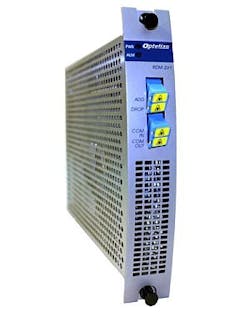Network cards from Optelian allow reconfigurable optical add/drop multiplexing, network monitoring
The RDM-2x1 system card is for reconfigurable optical add/drop multiplexing and the OCM-40 is for network
monitoring applications. The first allows unrestricted add/drop of 40 channels at 100 GHz spacing, with >15 dB dynamic range. The second continuously monitors optical power levels of forty 100 GHz-spaced DWDM channels.
Optelian
Ottawa, ON, Canada
www.optelian.com
-----
PRESS RELEASE
Optelian Expands Product Line; Adds ROADM and Network Monitoring Capabilities to Increase Operational Savings for Network Operators
Ottawa, ON/Marietta, GA, October 6, 2009 - Optelian, a trusted designer and manufacturer of optical transport systems, today announced the availability of two new system cards, the RDM-2x1 and OCM-40, for ROADM and Network Monitoring applications (images below).
“The RDM-2x1 and the OCM-40 are key building blocks in agile optical networks,” said Dave Mills, VP sales for Optelian. “With these new cards, network operators get all the benefits of LightGAIN systems including low power consumption, ease of deployment, and decades of worry-free operation.”
The capabilities enabled by Reconfigurable Optical Add Drop Multiplexing (ROADM), allow network operators to realize significant operational savings when reconfiguring optical channels at remote locations. Rather than sending technicians to a site, provisioning is done easily and quickly at the operations center. Traffic can be rerouted instantly in response to service requests or fiber cuts.
Optelian’s RDM-2x1 features include unrestricted add/drop of 40 channels at 100 GHz spacing, remote per-channel power equalization with > 15 dB dynamic range and exceptional optical specifications allow cascading of RDMs for all-optical transmission >1000 km.
Optical Channel Monitors (OCMs) that continuously monitor and report the optical power levels of all forty 100 GHz spaced DWDM channels are useful for remote performance monitoring, fault localization, and optical power balancing. Installing OCMs on new or existing DWDM and ROADM systems eliminates the need to dispatch technicians with expensive optical spectrum analyzers.
Optelian’s OCM-40 features two monitor inputs for simultaneous monitoring of both east and west directions, high accuracy over temperature and life with no user calibration needed and fast acquisition time of < 200 ms for a complete spectral scan of both ports.
